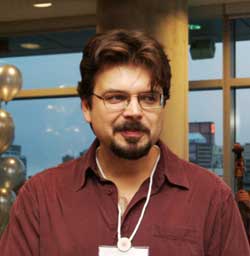Cutting off bacteria's food supply to slow them down

Peter Pawelek took time off the fight against bacteria to enjoy the Presidentís new faculty reception last month.
Image Photographique Internationale
With the rise of pathogenic bacteria that are resistant to antibiotics like penicillin, biochemists, immunologists and other health professionals are looking for alternative mechanisms and agents for their control.
“Our research may indicate new ways of starving them,” said Peter Pawelek.
Prior to joining Concordia’s Department of Chemistry and Biochemistry in July 2006, Pawelek worked with James Coulton at McGill examining the protein-protein interactions which can cause bacterial infections.
In order to survive inside a host, the nastiest bacteria on the planet — E. coli, salmonella, Vibrio cholerae, Yersinia pestis (the plague) — need iron, and lots of it. “It’s their food, “ said Pawelek, “but it’s very scarce.” To get enough iron, bacteria synthesize molecules called siderophores, and send them out “like harpoons” to bind with iron in the host.
The iron-carrying siderophores are then imported back into the bacteria by a group of associated proteins, known as a protein complex. “We discovered that the individual pieces of this complex fit together like a perfectly tooled Swiss watch,” said Pawelek. Their definition of the complex structure may help pharmaceutical companies develop drugs that will “throw a monkey wrench into the works” so that the complex never forms in the first place.
After the publication of results in the June 2, 2006 issue of Science, Pawelek moved to Concordia, excited by the university’s commitment to research. “The new Science Building at Loyola, access to common equipment — all of these things are really helpful for someone setting up a lab,” he said. “Concordia is really making great strides in enhancing its research profile.”
Now, Pawelek is using the technologies and methods developed at McGill to investigate bacterial iron uptake from another direction. He’s looking at how bacteria synthesize siderophores and send them out in search of iron. If successful this approach may provide clues for yet another pharmaceutical “monkey wrench.”
Results, however, will take a while because the proteins involved in these processes are notoriously difficult to work with. “It took nearly five years to get the structure we presented in the Science paper,” said Pawelek.
To find out how the proteins fit together, he is using a method called x-ray crystallography. Under the right conditions, proteins are crystallized and then examined using x-rays. By analyzing how the x-rays bounce off the repeating crystalline structure, Pawelek and his team will be able to map the structure of protein complexes. But the right conditions can be difficult to attain. Protein crystals can take weeks to form, and “if you bump the sample or the humidity changes,” the results can be disastrous.
Despite the challenges, Pawelek is looking forward to the research, and forming his team. “It’s an exciting, new field with lots of potential. I’m looking for grad students who are really interested in working with protein structures and protein-protein interactions.”
This winter, Pawelek will teach Discovering Biotechnology, a science class for non-scientists.
“We hear about transgenic plants, terminator seeds and using biotechnology to extend the shelf life of produce.” His course will focus on the science behind biotech issues so that students will be better able to evaluate the pros and cons, and to reach rational conclusions about their applications.